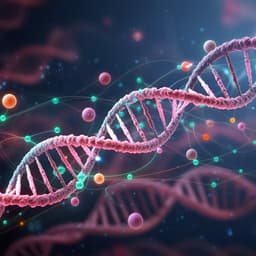
Biology
Prime editing with genuine Cas9 nickases minimizes unwanted indels
J. Lee, K. Lim, et al.
Discover how nCas9 nickases are changing the game in gene editing! This research by Jaesuk Lee and colleagues reveals the intricacies of nCas9 variants and their impact on DNA breaks and edits, paving the way for more precise genetic modifications.
~3 min • Beginner • English
Introduction
The study addresses the safety and specificity of Cas9-based genome editing, focusing on whether widely used Cas9 nickases are bona fide single-strand nicking enzymes or can inadvertently generate double-strand breaks (DSBs). While Cas9 nuclease creates DSBs enabling NHEJ/HDR editing, such breaks can cause large deletions, rearrangements, and cytotoxicity. Newer tools, base editors and prime editors, typically employ nCas9(D10A) or nCas9(H840A) to avoid DSBs. Prime editing (PE) uses nCas9(H840A) fused to Moloney murine leukemia virus reverse transcriptase and pegRNAs to install precise edits without donor DNA. However, PE has been associated with relatively high unwanted indels, reducing product purity. The authors hypothesize that nCas9(H840A) may sometimes cleave both strands to create DSBs, contributing to indel byproducts, and aim to engineer genuine nickases that avoid DSB formation, thereby improving PE outcome purity.
Literature Review
Foundational CRISPR-Cas9 genome editing and its risks from DSBs are well established (e.g., large deletions, chromothripsis, p53 activation). Base editing and prime editing were introduced to avoid DSBs, using nickase variants D10A (RuvC-inactivated) and H840A (HNH-inactivated). Prior work introduced epegRNAs that stabilize pegRNAs and increase PE efficiency but can also increase unwanted indels. Digenome-seq has been used broadly to map genome-wide off-targets for nucleases and editors. Structural studies of the HNH domain inform catalytic residues (e.g., H840, N863, D839, N854) critical for target-strand cleavage, guiding rational mutagenesis herein.
Methodology
- In vitro plasmid digestion assays: Supercoiled plasmids were incubated with purified WT Cas9, nCas9(D10A), or nCas9(H840A) plus sgRNA (HEK4 target) to assess nicking vs linearization by gel electrophoresis; Nt.BbvCI and SpeI served as nicking and DSB controls. Band intensities quantified with ImageJ.
- Digenome-seq: Genomic DNA from HEK293T cells was incubated in vitro with purified WT Cas9, nCas9(H840A), or engineered nCas9 variants (e.g., H840A+N863A) plus sgRNAs (HEK4, EMX1, RUNX1). Whole-genome sequencing (30–40×, HiSeq X Ten) and Digenome 2.0 analysis identified genome-wide cleavage sites and DSB patterns, visualized by IGV and Circos plots.
- Protein engineering: Additional alanine substitutions were introduced in the HNH domain near H840 (within 5 Å in PDB: 600Y), targeting residues N863, N854, D839, generating single, double, triple, and quadruple combinations; HNH-deletion variants were also constructed with various linker lengths.
- Mammalian cell assays: HEK293T (and later K562, HeLa) were transfected or nucleofected with plasmids encoding WT Cas9 or nCas9 variants and sgRNAs targeting up to 15 endogenous sites to quantify indel formation by targeted deep sequencing. For PE assays, PE2 and PE3 systems (with nicking sgRNA) incorporating nCas9 variants were tested with pegRNAs and epegRNAs (evopreQ1/mpknot motifs) across multiple loci (e.g., HEK3, RUNX1, FANCF, HEK4, VEGFA, etc.) for substitutions, 24-bp Flag-tag insertions, and 15-bp deletions.
- Targeted deep sequencing: Nested PCR library prep, Illumina MiniSeq paired-end. Custom Python pipelines quantified intended edits and unwanted indels; deletion events between predicted DSBs in PE3 assessed by size windows (±10 bp around expected distances).
- Statistics: Means ± SEM from three independent experiments; unpaired two-tailed Student’s t-test. Data analysis software included IGV, BWA, SAMtools, Prism, and PyMOL for structural visualization.
- Data/code availability: WGS deposited (PRJNA888859); analysis scripts available on GitHub/Zenodo.
Key Findings
- nCas9(H840A) can generate DSBs: In vitro plasmid assay showed nCas9(H840A) produced both open circular (56.7%) and linearized (43.4%) plasmid forms, unlike nCas9(D10A) (84.0% open circular) and Cas9 (99.7% linearized).
- Digenome-seq confirmation: At HEK4 on-target, nCas9(H840A) completely cleaved non-target strand and partially the target strand, yielding DSBs. Genome-wide DSB sites (mean ± SEM): WT Cas9, 260 ± 100; nCas9(H840A), 24 ± 10; nCas9(H840A+N863A), 2.7 ± 0.3; untreated, 2.0 ± 0.0.
- Engineering genuine nickases: Adding N863A to nCas9(H840A) eliminated target-strand cleavage in vitro and produced clean non-target strand nicks at multiple loci (HEK4, EMX1, RUNX1). In HEK293T, average indel frequencies across 15 sites: WT Cas9, 63 ± 2%; nCas9(H840A), 2.5 ± 0.6%; nCas9(H840A+N863A), 0.34 ± 0.06%.
- Additional HNH mutations further reduce indels: Variants exhibited even lower indel rates across 15 sites: H840A+N854A, 0.03 ± 0.01%; H840A+N863A+N854A, 0.02 ± 0.01%; H840A+N863A+D839A+N854A, 0.03 ± 0.01%.
- Off-target indels validated: Low-frequency indels detected at some off-target sites (e.g., RUNX1 off-2 site: 0.027% with nCas9(H840A), 0.035% with PE2).
- PE2 performance: Intended single-base edits (mean): PE2(H840A), 23 ± 6% (4.2–65%). Several PE2 variants with HNH mutations retained similar intended edit efficiency (19–23% average). Unwanted indels: PE2(H840A), 0.60 ± 0.17%; reduced 2.6–4.4-fold by PE2(H840A+N863A), PE2(H840A+N854A), PE2(H840A+N854A+N863A), PE2(D839A+H840A+N854A), and PE2(D839A+H840A+N854A+N863A). Ratio of unwanted indels among edited reads: PE2(H840A), 4.3%; reduced to 1.1% [H840A+N863A], 0.77% [H840A+N854A], 1.1% [H840A+N864A+N863A].
- PE3 performance: Intended edits averaged 32 ± 2% for PE3(H840A) and 30 ± 2% for PE3(H840A+N863A) (ns). Unwanted indels reduced from 4.3 ± 0.4% to 2.6 ± 0.3% with H840A+N863A. Variants H840A+N854A and H840A+N854A+N863A had lower indels but also lower intended edits (9.9 ± 1.0% and 6.9 ± 0.7%). Deletions between pegRNA/sgRNA cut sites decreased markedly: e.g., FANCF 48 ± 10 bp deletion, from 2.41 ± 0.12% [H840A] to 1.72 ± 0.13% [H840A+N863A], 0.12 ± 0.04% [H840A+N854A], 0.01 ± 0.01% [H840A+N854A+N863A]. Relative editing purity ratios increased 1.8×, 9.5×, and 9.4× for H840A+N863A, H840A+N854A, and H840A+N854A+N863A, respectively; average editing purity: 85.63% [H840A], 90.21% [H840A+N863A], 95.17% [H840A+N854A], 94.72% [H840A+N854A+N863A].
- epegRNAs (ePE3): For substitutions, ePE3(H840A+N863A) maintained correct edit frequency (33 ± 2% vs 32 ± 2% for H840A) while reducing unwanted indels (7 ± 0.9% vs 10 ± 1%). ePE3(H840A+N854A) achieved 18 ± 1.5% correct substitutions with minimal indels (0.67 ± 0.11%), leading to purity up to 95.7–96.5% and up to 14.5-fold higher relative purity ratio. For 24-bp Flag insertions: ePE3(H840A+N863A) correct 17.8 ± 1.7% (vs 19.3 ± 1.7%), indels 3.5 ± 0.7% (vs 6.2 ± 1.2%), purity 86.0% (vs 79.4%); ePE3(H840A+N854A) correct 6.8 ± 1.0%, indels 0.61 ± 0.11%, highest purity 91%. For 15-bp deletions: ePE3(H840A+N863A) correct 48.4 ± 5.4% (vs 49.6 ± 5.0%) with reduced indels; ePE3(H840A+N854A) correct 26.5 ± 4.9%, indels 1.1 ± 0.3%, average purity up to 96% (vs 87%).
- Cross-cell line validation: In K562 and HeLa, ePE3 variants increased relative editing purity up to ~2.6× and ~2.1×, respectively, with average purities improved versus ePE3(H840A).
Discussion
The findings confirm the hypothesis that nCas9(H840A), the standard nickase used in prime editing, is not strictly a nickase and can produce unintended DSBs, thereby contributing to unwanted indels. Structure-guided mutations in the HNH domain (notably N863A, and combinations with N854A and D839A) eliminated target-strand cleavage activity, generating genuine non-target-strand nickases. Incorporating these engineered nickases into prime editors (PE2, PE3, and ePE3) retained intended editing activity while significantly reducing indels and increasing editing purity. The reduction of genome-wide DSBs observed by Digenome-seq underscores improved specificity and safety. These advances address a central challenge for prime editing—balancing efficiency with minimal byproducts—and have important implications for therapeutic applications where purity and safety are paramount.
Conclusion
This work establishes that conventional nCas9(H840A) can inadvertently create DSBs and that additional HNH-domain mutations yield bona fide nickases. Incorporating nCas9(H840A+N863A) and nCas9(H840A+N854A) into prime editors reduces unwanted indels across PE2/PE3 systems and, with epegRNAs, attains very high editing purity (up to ~96.5%) without compromising or while minimally affecting intended edit frequencies. These engineered prime editors offer improved safety profiles for precise genome editing. Future work should evaluate these variants in primary cells and in vivo models, explore broader target scopes and pegRNA designs (including newer stabilized pegRNAs), and investigate compatibility with delivery modalities suitable for clinical translation.
Limitations
- Experiments were primarily performed in vitro and in immortalized cell lines (HEK293T, K562, HeLa); in vivo performance and primary cell contexts remain to be tested.
- Some HNH mutations (e.g., N854A-containing constructs) reduced intended edit frequencies in PE3, indicating potential trade-offs in activity versus purity.
- Off-target analyses relied on in vitro Digenome-seq and targeted validation at candidate sites; comprehensive in-cell, genome-wide off-target nick/DSB profiling could be expanded.
- The study notes potential effects of HNH mutations on protein folding/binding; detailed biochemical/structural validation in cellular context was limited.
- Experimental procedures were not randomized or blinded; mycoplasma testing was not performed, which could potentially affect cell-based results.
- Certain variant notations (e.g., N864A) appear in text and may reflect typographical inconsistencies; full variant characterization beyond tested sets may be required.
Related Publications
Explore these studies to deepen your understanding of the subject.







